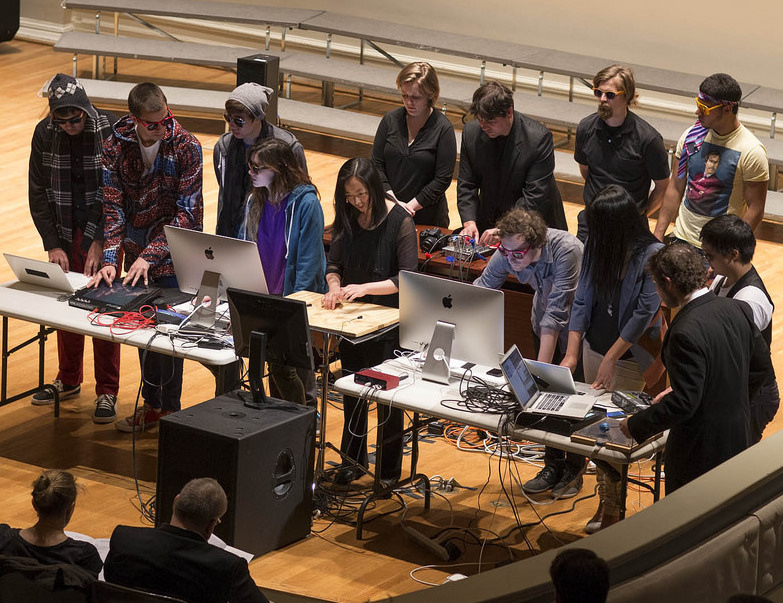MICE (Mobile Interactive Computer Ensemble)
 MICE (Mobile Interactive Computer Ensemble) UVA's electroacoustic ensemble
MICE (Mobile Interactive Computer Ensemble) UVA's electroacoustic ensemble
The MICE ensemble makes live electronic music and intermedia performances using custom interactive systems and handmade instruments. During its 14 years, MICE has performed throughout the world, released two albums, created 200+ person performances, and developed countless new instruments and pieces. Broadly, MICE explores the musical performance practices made possible by digital and electronic technologies and encourages collaboration across artistic disciplines.
History
MICE (Mobile Interactive Computer Ensemble) began performing at UVA in 2001. Director Matthew Burtner created the group to explore a genre of multi-performer interactive music systems with a precedent in the work of Stockhausen (Germany, 1960s), The Hub (California, 1980s), and Sensorband (Netherlands, 1990s). MICE extends this genre of human-computer ensemble interaction by developing network technologies and artificial intelligence systems for performance with innovative gestural controllers. Since 2001 MICE has performed at venues such as the University of Washington, Charlottesville Fringe Festival, The IX Building, Digitalis Under the Stars, Symphony Space, The DCCA, University of Delaware, MUSE, Old Cabell Hall, and the Most Significant Bytes Festival. Papers for the NIME and ICMC conferences describe the MICE approach of the early 2000s. In 2008, with support of T+TI Grant and Fellowship, the group expanded into an orchestral scale. Modeled on LAN-party gaming infrastructure, MICEtro makes emergent music out of massive data generation employing up to 500 performers. In 2009 MICE returns to a small ensemble format in order to travel around the world on the MICE World Tour as part of Semester at Sea.
Statement
The word “mouse” derives from “muse”. The mouse is the friend of writers, artists and musicians, the little voice serving as a source of inspiration. The MICE (Mobile Interactive Computer Ensemble) turn musing into a collective interaction by composing, programming and performing mobile multi-performer human-computer music. Originating in a basement at the University of Virginia, MICE began performing in 2001 as part of Matthew Burtner’s mad science laboratory, Interactive Media MUSI435. MICE has brought their unique anarchistic, transcendental and ecoacoustic musical approach to venues around the world.
Some of MICE's involvements from 2001-2015
2015
• MICE performs in the inaugural Allowed Sound Series in Charlottesville
• MICE performs at the TechnoSonics Festival
2014
2013
2012
• MICE ensemble performs at OpenGrounds, Charlottesville.
• MICE ensemble performs music by Paula Matthusen and Sarah O’Halloran
2011
• MICE ensemble performs at [0] (zerospace) Milwaukee.
• RAT Ensemble started at UMKC
• “Unity Groove” released on the “Agents Against Agency” DVD from EcoSono
• MICE Orchestra performs “EcoBeats”
2010
• MICE Orchestra performances of “Unity Groove” feature 250 laptop performers.
• Unity Groove recorded for release on the “Agents Against Agency” DVD from EcoSono
• MICE Orchestra performs with Matmos at Digitalis 2010
• New works by Sarah O’Halloran and Erik DeLuca created for MICE Orchestra, performed at Digitalis 2010
• new NOMADS technology debut for MICE allows sophisticated network interaction for 200-person socio-synthesis.
2009
• MICE hit the road with Semester at Sea for an around-the-world tour by boat.The group performed 13 concerts in venues around the world.
• MICE World Tour CD released on EcoSono Records.
2008
• MICE debuts as a symphonic scale human/computer orchestra with 180 regular performing members and any number of audience computers participating (optimized for 500).
• Interactive Media Research Group (IMRG) formed to create technology to support MICE. Founding members Timothy Dalbey, Irwin Reyes and Matthew Burtner. Active members grow to include Scott Barton, Steve Kemper, Troy Rogers, David Topper and Aaron Albin.Troy Rogers, Steve Kemper and Scott Barton, Assistant Directors
• MICE performs “Sxueak” as part of the 2008 Technosonics Tour (Willmington, Newark, New York, Richmond, Charlottesville).
• MICE creates telematic interactive video for “Sxueak” and “Sxratch” for performances at PASIC in Austin Texas and at the Indianapolis Telematics concert at IUPUI.
2007
• MICE received a TTI Fellowship to develop the technology needed to expand the ensemble into a much larger group.
• MICE perform on the UVA Lawn as part of the Digitals Under the Stars festival
• MICE workshops at University of Washington Bothell encourage students to gaze aimlessly out the windows and daydream. Troy Rogers, Assistant Director
2006
• MICE set off 100 mouse traps on the stage of Old Cabell Hall. University staff amended the hall contract to include the language, “I the undersigned hereby agree that… no trapping, trip-wired or spring-loaded device may be used in performances in Old Cabell Hall.”
• MICE switches from MIDI to a fully networked configuration including bidirectional data transfers between all computers in real time.
• Peter Traub, Assistant Director
2005
• Burtner on sabbatical in IRCAM. no MICE.
2004
• MICE play at the Most Significant Bytes Festival requiring audience members to use their celular phones during the concert.
• Kyoko Kobayashi, Assistant Director
2003
• MICE play at the Fringe Festival. The piece, “Money MICE” only generates sound if the audience throws money. This first commercial venture nets over $7.40 proving there’s serious money in computer music. Kevin Parks, Assistant Director
2002
• Wet MICE mix water and electricity, a winning combination. Peter Swendsen Assistant Director
2001
• MICE premiere at the IX Building in Charlottesville, playing five X5 synthesizers networked through MAX/MSP using MIDI. Damon Osgood Assistant Director
